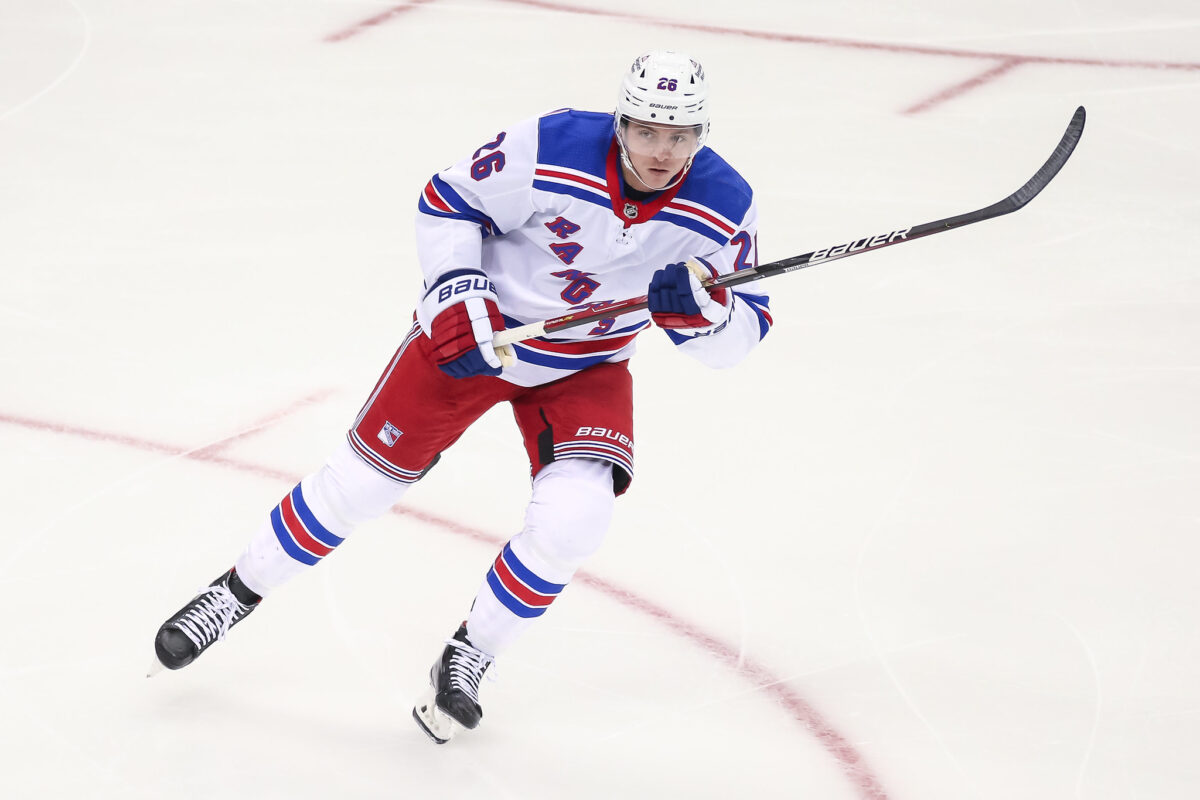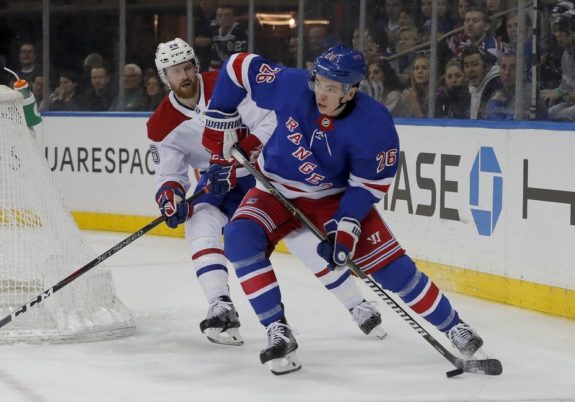The days of expecting New York Rangers winger Jimmy Vesey to develop into a high-scoring, top-six forward are long gone.
That doesn’t mean the former Harvard University star is some cliched case of a highly-regarded player who failed to achieve success at the highest professional level of hockey. On the contrary, Vesey’s long road from Cambridge to New York to what amounted to the NHL wilderness for him, then back to New York, might have the 30-year-old set up for what could end up being the best seasons of his career, starting in 2023-24.
Heading into his second season with the Rangers, there seems little chance that Vesey will suddenly unleash the scoring touch that saw him score 56 goals and add 48 assists in 70 games over his junior and senior years with the Crimson. His first 20-goal season in the NHL, however, just might be in reach, and if last season was any indication, such offensive production would be icing on the cake. Instead of being a player who simply didn’t live up to early expectations, Vesey is a guy who, through adversity and the growth that comes with it, has gone from rock bottom to turning himself into a complete player.

The Vesey that made the Rangers roster off of a Professional Try Out contract in training camp last year was a far different player than the one who arrived on Broadway in 2016, then a 23-year-old who had caused a stir by refusing to sign with the Nashville Predators, who had drafted him in the third round in 2012, and then the Buffalo Sabres, who acquired his negotiating rights two months later. Gaining free agency four years after being drafted per the rules of the NHL collective bargaining agreement, Vesey inked an entry-level contract with the Blueshirts – ending a much-hyped process that had included pleas from numerous celebrity fans of the Rangers to join the team.
Vesey’s Rough Road After Leaving Rangers Proved Vital
The fit never felt right, however, even as Vesey scored 50 goals over his first three seasons as a Ranger while playing all but six games during that stretch. Likely burdened by expectation, perhaps brought on by his high-profile spurning of two teams to join the team of his choice, Vesey always seemed uncertain of himself, trying to forge a starring role in the top six – a spot for which he appeared miscast. He posted a minus-37 mark in those three seasons, even though his possession numbers weren’t bad.
Still, it was the change of scenery that followed that may have made it possible for Vesey to get to where he is now. Traded by the Rangers to the Sabres after the 2018-19 season, Vesey bounced from Buffalo to the Vancouver Canucks to the New Jersey Devils over the next three seasons, hitting a low point during 50 games split between the Toronto Maple Leafs and Canucks.

“I was up in Canada during the (2020-21) COVID year, locked down, by myself,” Vesey said in an interview last September. “I didn’t play well. It was very hard on me.
“It was a miserable experience.” (From ‘Jimmy Vesey Reinvented Himself For Second Rangers Act After ‘Miserable’ Career Turn’, New York Post, 9/26/22)
Perhaps, but that experience made Vesey realize he needed to change to keep wearing an NHL jersey. That any preconceived notions of what he or anyone else thought he would become in the NHL needed to be wiped away. He had to essentially start from scratch.
“After the year in Canada, I took ownership of the fact that I had to re-invent myself as a fourth-line guy who could kill penalties,” he said. “I’m not one for pumping my own tires, but I think I did a pretty good job of that.”
The signs that something was different came the next season, when Vesey earned a spot on the Devils’ roster off a PTO deal. He became a fixture on New Jersey’s top penalty-killing unit, excelling in the role while chipping in eight goals and seven assists in 68 games.
That modestly impressive performance was hardly enough to make him a hot commodity, forcing Vesey to take the PTO route to a roster spot again. This time, it was with the Rangers, the team he had worked to make his way to six years prior.
And this time, it was indeed different on Broadway for Vesey. He signed a one-year, $750,000 contract and played 81 games, scored 11 goals with 14 assists, excelled again as a penalty killer and provided versatility up and down the lineup in a way he couldn’t in his first go-round in a Blueshirt. The transformation to an inherently valuable NHL asset clearly complete, Vesey jumped at a two-year, $1.6 million extension offer from the front office in January.

The bargain-basement salary was hardly a concern for the Boston native.
“To be candid with you, that hype (over his potential) never came from me,” Vesey said. “I always envisioned myself as a 20-goal guy and when I left here after three years, I thought I pretty much had figured it out.
” … You know the big thing for me has always been confidence.”
After Adversity, Vesey Could Be at Start of Upward Trend
If the last two seasons were about Vesey re-establishing the belief that he could excel in the NHL, it’s worth considering whether at age 30, he’s actually an ascending player. Comfortable with where he’s at geographically and with his game, and with some contract security, might the now-savvy veteran of seven seasons be ready to further unlock the offensive abilities that sparked so much interest in him in his early 20s?
Possibly. When Vesey wasn’t playing on the fourth line last season, he spent time on a third forward unit with Chris Kreider – whose own later-career ascent has resulted in 88 goals over the past two seasons – and though their time together was somewhat limited, the effects of the partnership were clear. Vesey and Kreider were on the ice together at 5 on 5 for 267:40 last season and posted a 56.14 Corsi for percentage and 57.8 expected goals for percentage, with 55 high-danger chances for to 45 against. Interestingly, Vesey’s CF% last season without Kreider was 49.34; Kreider had a 49.7 mark without Vesey.

Those numbers are something new coach Peter Laviolette might want to take into consideration as his lines take shape in training camp and into the season. Vesey, the self-proclaimed re-invented fourth-liner, seems likely to spend more time on the third unit in 2023-24 with the Rangers having added a gaggle of bottom-line candidates in free agency. Should Laviolette want to, say, get more top-six time for young forward Alexis Lafreniere, Kreider and Vesey could form a consequential unit with Vincent Trocheck or Filip Chytil as their center.
With those kinds of consistent linemates, Vesey would theoretically have more opportunities to flash the offensive tools that still showed up from time to time last season – the strong wrist shot, the speed, the size that allows him to get to the net and finish. Should that side of his game further emerge, Vesey would be providing the Rangers with exceptional bang for the buck.
Related: Cap-Strapped Rangers Ready to Depend Heavily on Spare Parts
Perhaps that won’t happen. Perhaps Vesey is what he is at this point, a glue guy who contributes in a variety of ways but won’t ever move the needle offensively in the NHL the way he did in college.

That, however, would still be more than enough for the Rangers, who need as many players like Vesey as they can get. Facing a salary-cap crunch, the club is desperate for low-salary, high-value bottom-sixers who have a positive impact when they’re on the ice.
It’s surely more than enough for Vesey, who, even if he doesn’t continue his rise of the past two seasons, has arrived as a solid NHL player who’s again wanted by the team who wanted him at the outset of his career.

